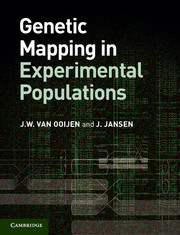Book contents
- Frontmatter
- Contents
- Preface
- 1 Introduction
- 2 Meiosis and genetic recombination
- 3 Estimation of recombination frequencies
- 4 Determination of linkage groups
- 5 Estimation of a genetic map
- 6 Criteria for the evaluation of maps
- 7 How to find the best map order
- 8 Outbreeding species
- 9 Mapping in practice
- Answers to exercises
- Index
- References
3 - Estimation of recombination frequencies
Published online by Cambridge University Press: 05 August 2013
- Frontmatter
- Contents
- Preface
- 1 Introduction
- 2 Meiosis and genetic recombination
- 3 Estimation of recombination frequencies
- 4 Determination of linkage groups
- 5 Estimation of a genetic map
- 6 Criteria for the evaluation of maps
- 7 How to find the best map order
- 8 Outbreeding species
- 9 Mapping in practice
- Answers to exercises
- Index
- References
Summary
The rate of recombination between two loci is a measure of the distance these loci are apart on the chromosomes. Measuring these values for all loci is the starting point for estimating the map of the loci. In Chapter 2, the recombination frequency of two loci was introduced as the measure of genetic recombination: this is the proportion of gametes that are recombinant between the two loci in a single meiosis. A complication with higher plants and animals is that we do not observe the gametes but the diploid individuals in which two gametes are combined. Because in diploids two alleles are present for each locus, there is not always a one-to-one relationship between the observation of a locus and its genotype. Strictly speaking, we should use the term phenotype for observations regarding the genotype. In some cases, it is possible to determine exactly the genotype from the phenotype, for instance in the backcross. In such cases, estimates of recombination frequencies can be obtained by simple counting. We show that the same estimates are obtained by employing the maximum likelihood principle. This same principle can then also be employed in situations where there is no one-to-one relationship between phenotype and genotype. In yet other situations, recombinant genotypes are the result of several subsequent meioses. Here, the observed recombination must be translated into the probability of recombination in a single meiosis.
What do we observe? From separate loci to pairs, from phenotype to genotype
Recombination is a phenomenon that occurs with respect to pairs of genes or markers. In a regular linkage analysis, however, we start with observing the phenotypes of loci separately. Only as a next step are the observations combined into pairs, which allows the study of recombination. Let us first look at phenotypes: what exactly is a phenotype? The term phenotype was introduced by the Danish geneticist W. Johannsen back in 1909 in order to be able to make the distinction between what is observed of an organism and its genetic constitution. By definition, a phenotype is what we can observe of the genotype of an individual. Although somewhat confusing, the pleasant characteristic of many genetic markers is that the phenotype is equal to the genotype. This is why the words are regularly used as synonymous in the context of linkage analysis. However, there can be a major difference.
Information
- Type
- Chapter
- Information
- Genetic Mapping in Experimental Populations , pp. 21 - 44Publisher: Cambridge University PressPrint publication year: 2013
